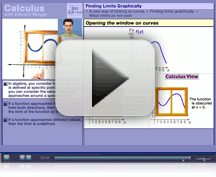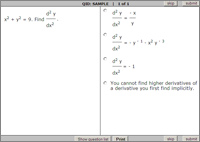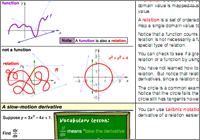Calculus BC compatible with AP*
Did you know that fewer than 50% of students taking the AP Calculus exam make a 3 or above? The AP Calculus BC exam is one of the toughest around. Get a leg up on this difficult subject by learning the fundamentals of calculus from award-winning professor Edward Burger.
Professor Burger teaches you basis behind the powerful ideas of calculus—you'll learn and remember exactly what you need to know to ace the Calculus BC exam by using calculus on the web instead of an old-fashioned textbook or study aid. And, Professor Burger's videos are available 24/7 for one flat price, so Thinkwell is better than a tutor. Thinkwell's online Calculus BC subscription gives you access to a complete web-based solution that includes all of the content you'll need to succeed in AP Calculus.
The AP Calculus BC exam requires mastery of the AB topics; Calculus AB compatible with AP is sold separately.
Our complete Calculus BC compatible with AP* package includes:- 12-month Online Subscription to our complete Calculus BC course with video lessons, automatically graded Calculus BC problems, and much more
- Printed Notes (optional, AB + BC) are the AP Calculus course notes from the Online Subscription printed in a black & white, on-the-go format. These are available for purchase from the AP Calculus BC Course Site.
Printed Notes require the purchase of an online subscription.
(*AP is a registered trademark of the College Board, which was not involved in the production of, and does not endorse, this product.)
Money-Back Guarantee
Calculus BC compatible with AP* Materials
Online Subscription, 12-month access
Access to a complete online package that includes everything you need.
- Thinkwell's video lectures cover the comprehensive scope and sequence of topics covered on the AP Calculus BC exam.
- Our automatically graded exercises with immediate feedback allow you to quickly determine which areas you'll need to spend extra time studying.
- Concise, illustrated review notes help you distill the fundamental ideas, concepts, and formulas from Calculus you'll need to know in order to succeed on the AP Calculus exam.
- Subscriptions start when you are ready. Buy now and activate your course anytime you like. Wait up to one year to activate your subscription; your 12-month subscription doesn't begin until you say so!
Calculus BC compatible with AP* Details
Thinkwell's Calculus BC includes all of these features to prepare you for the big exam:
- Equivalent to 11th- or 12th-grade AP Calculus BC
- More than 100 video lessons (see sample)
- 1000+ interactive AP Calculus BC problems with immediate feedback allow you to track your progress (see sample)
- Calculus BC practice chapter tests for all 5 chapters, as well as a final exam to make sure you're ready for the AP Calculus BC exam (only available in the homeschool version).
- Printable illustrated notes for each topic
- Real-world application examples in both lectures and exercises
- Closed captioning for all videos
- Glossary of more than 200 mathematical terms
- Engaging content to help students advance their mathematical knowledge:
- Indeterminate forms and L'Hopital's rule
- Elementary functions and their inverses
- Techniques of integration, including integration by partial fractions and trigonometric substitution
- Improper integrals
- Disks, washers, shells, and other applications of integral calculus
- Sequences and series
- Differential equations
- Parametric equations and polar coordinates
- Vector calculus
Table of Contents
(Expand All - Close All)1. An Introduction to Calculus BC
- 1.1 Introduction
- 1.1.1 Welcome to Calculus II
- 1.1.2 Review: Calculus I in 20 Minutes
2. Techniques of Integration
- 2.1 Integration Using Tables
- 2.1.1 An Introduction to the Integral Table
- 2.1.2 Making u-Substitutions
- 2.2 Integrals Involving Powers of Sine and Cosine
- 2.2.1 An Introduction to Integrals with Powers of Sine and Cosine
- 2.2.2 Integrals with Powers of Sine and Cosine
- 2.2.3 Integrals with Even and Odd Powers of Sine and Cosine
- 2.3 Integrals Involving Powers of Other Trigonometric Functions
- 2.3.1 Integrals of Other Trigonometric Functions
- 2.3.2 Integrals with Odd Powers of Tangent and Any Power of Secant
- 2.3.3 Integrals with Even Powers of Secant and Any Power of Tangent
- 2.4 An Introduction to Integration by Partial Fractions
- 2.4.1 Finding Partial Fraction Decompositions
- 2.4.2 Partial Fractions
- 2.4.3 Long Division
- 2.5 Integration by Partial Fractions with Repeated Factors
- 2.5.1 Repeated Linear Factors: Part One
- 2.5.2 Repeated Linear Factors: Part Two
- 2.5.3 Distinct and Repeated Quadratic Factors
- 2.5.4 Partial Fractions of Transcendental Functions
- 2.6 Integration by Parts
- 2.6.1 An Introduction to Integration by Parts
- 2.6.2 Applying Integration by Parts to the Natural Log Function
- 2.6.3 Inspirational Examples of Integration by Parts
- 2.6.4 Repeated Application of Integration by Parts
- 2.6.5 Algebraic Manipulation and Integration by Parts
- 2.7 An Introduction to Trigonometric Substitution
- 2.7.1 Converting Radicals into Trigonometric Expressions
- 2.7.2 Using Trigonometric Substitution to Integrate Radicals
- 2.7.3 Trigonometric Substitutions on Rational Powers
- 2.8 Trigonometric Substitution Strategy
- 2.8.1 An Overview of Trigonometric Substitution Strategy
- 2.8.2 Trigonometric Substitution Involving a Definite Integral: Part One
- 2.8.3 Trigonometric Substitution Involving a Definite Integral: Part Two
- 2.9 The Calculus of Inverse Trigonometric Functions
- 2.9.1 More Calculus of Inverse Trigonometric Functions
3. Parametric Equations and Polar Coordinates
- 3.1 Understanding Parametric Equations
- 3.1.1 An Introduction to Parametric Equations
- 3.1.2 The Cycloid
- 3.1.3 Eliminating Parameters
- 3.2 Calculus and Parametric Equations
- 3.2.1 Derivatives of Parametric Equations
- 3.2.2 Graphing the Elliptic Curve
- 3.2.3 The Arc Length of a Parameterized Curve
- 3.2.4 Finding Arc Lengths of Curves Given by Parametric Equations
- 3.3 Understanding Polar Coordinates
- 3.3.1 The Polar Coordinate System
- 3.3.2 Converting between Polar and Cartesian Forms
- 3.3.3 Spirals and Circles
- 3.3.4 Graphing Some Special Polar Functions
- 3.4 Polar Functions and Slope
- 3.4.1 Calculus and the Rose Curve
- 3.4.2 Finding the Slopes of Tangent Lines in Polar Form
- 3.5 Polar Functions and Area
- 3.5.1 Heading toward the Area of a Polar Region
- 3.5.2 Finding the Area of a Polar Region: Part One
- 3.5.3 Finding the Area of a Polar Region: Part Two
- 3.5.4 The Area of a Region Bounded by Two Polar Curves: Part One
- 3.5.5 The Area of a Region Bounded by Two Polar Curves: Part Two
4. Sequences and Series
- 4.1 Sequences
- 4.1.1 The Limit of a Sequence
- 4.1.2 Determining the Limit of a Sequence
- 4.1.3 The Squeeze and Absolute Value Theorems
- 4.2 Monotonic and Bounded Sequences
- 4.2.1 Monotonic and Bounded Sequences
- 4.3 Infinite Series
- 4.3.1 An Introduction to Infinite Series
- 4.3.2 The Summation of Infinite Series
- 4.3.3 Geometric Series
- 4.3.4 Telescoping Series
- 4.3.5 Applications of Series
- 4.4 Convergence and Divergence
- 4.4.1 Properties of Convergent Series
- 4.4.2 The nth-Term Test for Divergence
- 4.5 The Integral Test
- 4.5.1 An Introduction to the Integral Test
- 4.5.2 Examples of the Integral Test
- 4.5.3 Using the Integral Test
- 4.5.4 Defining p-Series
- 4.6 The Direct Comparison Test
- 4.6.1 An Introduction to the Direct Comparison Test
- 4.6.2 Using the Direct Comparison Test
- 4.7 The Limit Comparison Test
- 4.7.1 An Introduction to the Limit Comparison Test
- 4.7.2 Using the Limit Comparison Test
- 4.7.3 Inverting the Series in the Limit Comparison Test
- 4.8 The Alternating Series
- 4.8.1 Alternating Series
- 4.8.2 The Alternating Series Test
- 4.8.3 Estimating the Sum of an Alternating Series
- 4.9 Absolute and Conditional Convergences
- 4.9.1 Absolute and Conditional Convergence
- 4.10 The Ratio and Root Tests
- 4.10.1 The Ratio Test
- 4.10.2 Examples of the Ratio Test
- 4.10.3 The Root Test
- 4.11 Polynomial Approximations of Elementary Functions
- 4.11.1 Polynomial Approximation of Elementary Functions
- 4.11.2 Higher-Degree Approximations
- 4.12 Taylor and Maclaurin Polynomials
- 4.12.1 Taylor Polynomials
- 4.12.2 Maclaurin Polynomials
- 4.12.3 The Remainder of a Taylor Polynomial
- 4.12.4 Approximating the Value of a Function
- 4.13 Taylor and Maclaurin Series
- 4.13.1 Taylor Series
- 4.13.2 Examples of the Taylor and Maclaurin Series
- 4.13.3 New Taylor Series
- 4.13.4 The Convergence of Taylor Series
- 4.14 Power Series
- 4.14.1 The Definition of Power Series
- 4.14.2 The Interval and Radius of Convergence
- 4.14.3 Finding the Interval and Radius of Convergence: Part One
- 4.14.4 Finding the Interval and Radius of Convergence: Part Two
- 4.14.5 Finding the Interval and Radius of Convergence: Part Three
- 4.15 Power Series Representations of Functions
- 4.15.1 Differentiation and Integration of Power Series
- 4.15.2 Finding Power Series Representations by Differentiation
- 4.15.3 Finding Power Series Representations by Integration
- 4.15.4 Integrating Functions Using Power Series
5. Differential Equations
- 5.1 Solving a Homogeneous Differential Equation
- 5.1.1 Separating Homogeneous Differential Equations
- 5.1.2 Change of Variables
- 5.2 Solving First-Order Linear Differential Equations
- 5.2.1 First-Order Linear Differential Equations
- 5.2.2 Using Integrating Factors
6. Vector Calculus and the Geometry of R2 and R3
- 6.1 Vectors and the Geometry of R2 and R3
- 6.1.1 Coordinate Geometry in Three-Dimensional Space
- 6.1.2 Introduction to Vectors
- 6.1.3 Vectors in R2 and R3
- 6.1.4 An Introduction to the Dot Product
- 6.1.5 Orthogonal Projections
- 6.1.6 An Introduction to the Cross Product
- 6.1.7 Geometry of the Cross Product
- 6.1.8 Equations of Lines and Planes in R3
- 6.2 Vector Functions
- 6.2.1 Introduction to Vector Functions
- 6.2.2 Derivatives of Vector Functions
- 6.2.3 Vector Functions: Smooth Curves
- 6.2.4 Vector Functions: Velocity and Acceleration
About the Author

Sample Video Lessons

Sample Interactive Exercises


